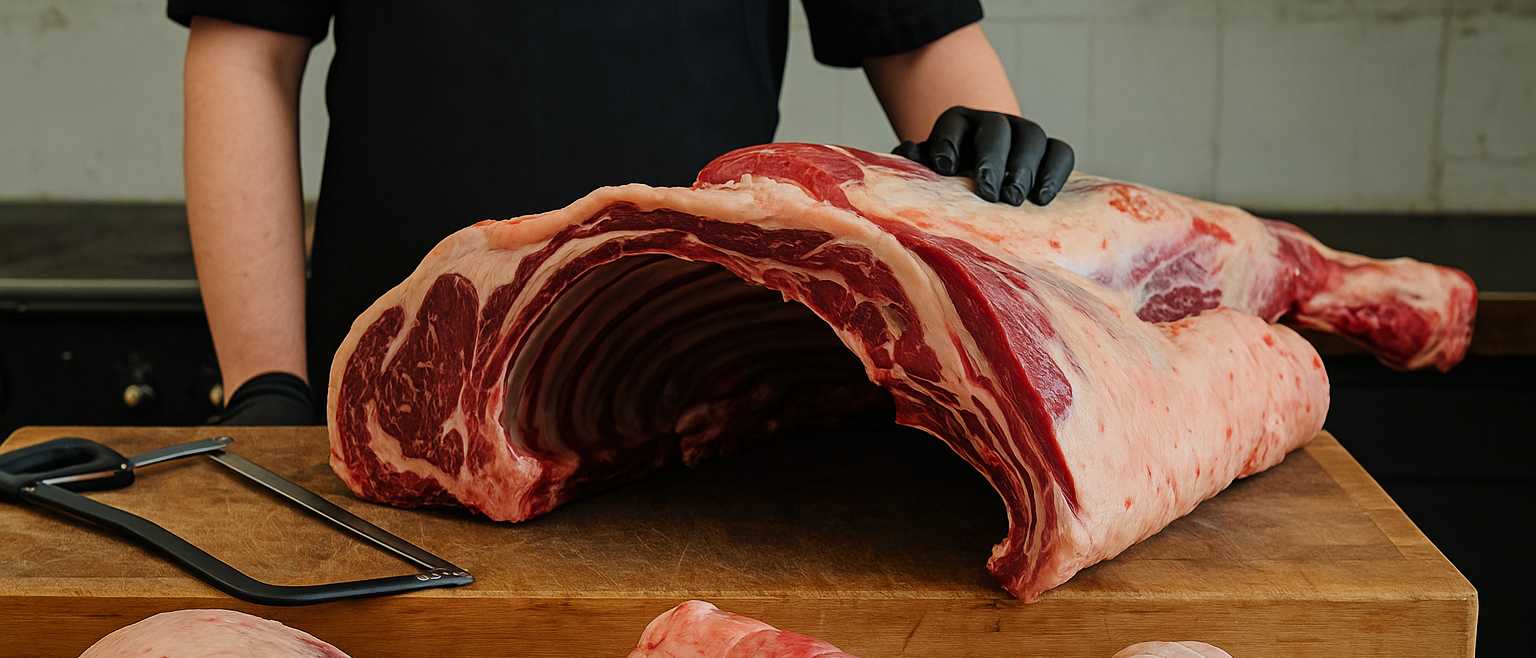
Forequarter
Includes the chuck, neck, shin, and brisket. These are the engine room of the animal — hard-working muscles loaded with connective tissue, collagen, and deep beefy flavour. Because of their toughness, they need slow, gentle cooking to unlock their richness.
Chuck and neck make brilliant, diced beef for stews and curries. Shin, rich in gelatin, melts into silkiness in a long braise. Brisket — the barbecue hero — is layered with fat and flavour, ideal for slow roasting or smoking.
| If You Only Remember One Thing: These are the flavour bombs. Low and slow turns them to gold. |
Middle Cuts / Rib Section
Here you’ll find ribeye, short ribs, and standing rib roasts. These are the cuts where fat, flavour, and tenderness meet in glorious harmony. The rib section sits between the forequarter and loin, offering balance: it’s tender enough for quick cooking, but with enough fat and marbling to stay juicy and flavourful.
Ribeye steaks are a classic — rich, juicy, and forgiving. Short ribs, on the other hand, benefit from a long braise to fall-off-the-bone tenderness. A standing rib roast is one of the most spectacular centrepieces you can serve.
| If You Only Remember One Thing: The sweet spot between tenderness and taste. A butcher’s favourite. |
Sirloin & Rump
This is the business end for many steak lovers. Sirloin is known for its balance of tenderness and beefy character. It’s leaner than ribeye but still full of flavour when properly aged. Rump sits just behind it and is a working muscle — a little firmer but beautifully flavoured.
The rump cap (also known as picanha in Brazil) is a triangular muscle with a thick fat cap. It’s ideal for roasting whole or cutting into thick steaks for grilling. Treat it with care, slice it against the grain, and it rewards with incredible depth of flavour.
| If You Only Remember One Thing: Go for rump cap if you want to impress steak lovers on a budget. |
Hindquarter / Leg
Cuts here include topside, silverside, knuckle, and shin. These muscles do a lot of work and tend to be lean and tightly grained. They’re not tender by default, but they are deeply rewarding with the right technique.
Topside and silverside are often used for roasting or slicing cold. Silverside is also the traditional choice for salt beef. Knuckle (or thick flank) makes excellent lean mince, schnitzel, or flash-fried steak when sliced very thinly. Shin from the hind leg is denser than fore shin but just as rich when slow-cooked.
| If You Only Remember One Thing: Silverside isn’t just for boiling. Salt it, slice it, and make Reubens. |
This is the most tender cut on the animal. It runs along the inside of the spine, doing very little work, which means very little toughness. That tenderness comes at a cost — fillet is lean and subtle in flavour.
It’s a luxurious cut best suited to quick cooking: searing, grilling, or slicing raw as carpaccio or steak tartare. Fillet needs help — salt, fat (think butter-basting), and careful handling — to really shine.
| If You Only Remember One Thing: Fillet is the passenger, not the engine. Bring the flavour elsewhere. |